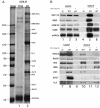Proteomics of herpes simplex virus replication compartments: association of cellular DNA replication, repair, recombination, and chromatin remodeling proteins with ICP8
- PMID: 15140983
- PMCID: PMC415816
- DOI: 10.1128/JVI.78.11.5856-5866.2004
Proteomics of herpes simplex virus replication compartments: association of cellular DNA replication, repair, recombination, and chromatin remodeling proteins with ICP8
Abstract
In this study, we have used immunoprecipitation and mass spectrometry to identify over 50 cellular and viral proteins that are associated with the herpes simplex virus 1 (HSV-1) ICP8 single-stranded DNA-binding protein. Many of the coprecipitating cellular proteins are known members of large cellular complexes involved in (i) DNA replication or damage repair, including RPA and MSH6; (ii) nonhomologous and homologous recombination, including the catalytic subunit of the DNA-dependent protein kinase, Ku86, and Rad50; and (iii) chromatin remodeling, including BRG1, BRM, hSNF2H, BAF155, mSin3a, and histone deacetylase 2. It appears that DNA mediates the association of certain proteins with ICP8, while more direct protein-protein interactions mediate the association with other proteins. A number of these proteins accumulate in viral replication compartments in the infected cell nucleus, indicating that these proteins may have a role in viral replication. WRN, which functions in cellular recombination pathways via its helicase and exonuclease activities, is not absolutely required for viral replication, as viral yields are only very slightly, if at all, decreased in WRN-deficient human primary fibroblasts compared to control cells. In Ku70-deficient murine embryonic fibroblasts, viral yields are increased by almost 50-fold, suggesting that the cellular nonhomologous end-joining pathway inhibits HSV replication. We hypothesize that some of the proteins coprecipitating with ICP8 are involved in HSV replication and may give new insight into viral replication mechanisms.
Figures


Similar articles
-
Herpes simplex virus 1 ICP8 mutant lacking annealing activity is deficient for viral DNA replication.Proc Natl Acad Sci U S A. 2019 Jan 15;116(3):1033-1042. doi: 10.1073/pnas.1817642116. Epub 2018 Dec 31. Proc Natl Acad Sci U S A. 2019. PMID: 30598436 Free PMC article.
-
Recruitment of polymerase to herpes simplex virus type 1 replication foci in cells expressing mutant primase (UL52) proteins.J Virol. 2003 Apr;77(7):4237-47. doi: 10.1128/jvi.77.7.4237-4247.2003. J Virol. 2003. PMID: 12634381 Free PMC article.
-
Assembly of complete, functionally active herpes simplex virus DNA replication compartments and recruitment of associated viral and cellular proteins in transient cotransfection assays.J Virol. 1997 Apr;71(4):3146-60. doi: 10.1128/JVI.71.4.3146-3160.1997. J Virol. 1997. PMID: 9060678 Free PMC article.
-
Werner syndrome protein: biochemical properties and functional interactions.Exp Gerontol. 2000 Sep;35(6-7):695-702. doi: 10.1016/s0531-5565(00)00145-5. Exp Gerontol. 2000. PMID: 11053659 Review.
-
[Biological functions of DNA helicase responsible for Werner syndrome].Tanpakushitsu Kakusan Koso. 2001 Jun;46(8 Suppl):1073-81. Tanpakushitsu Kakusan Koso. 2001. PMID: 11436295 Review. Japanese. No abstract available.
Cited by
-
Deregulation of DNA damage signal transduction by herpesvirus latency-associated M2.J Virol. 2006 Jun;80(12):5862-74. doi: 10.1128/JVI.02732-05. J Virol. 2006. PMID: 16731925 Free PMC article.
-
A guide to viral inclusions, membrane rearrangements, factories, and viroplasm produced during virus replication.Adv Virus Res. 2007;70:101-82. doi: 10.1016/S0065-3527(07)70004-0. Adv Virus Res. 2007. PMID: 17765705 Free PMC article. Review.
-
Transcriptional coactivator HCF-1 couples the histone chaperone Asf1b to HSV-1 DNA replication components.Proc Natl Acad Sci U S A. 2010 Feb 9;107(6):2461-6. doi: 10.1073/pnas.0911128107. Epub 2010 Jan 21. Proc Natl Acad Sci U S A. 2010. PMID: 20133788 Free PMC article.
-
Replication Compartments of DNA Viruses in the Nucleus: Location, Location, Location.Viruses. 2020 Jan 29;12(2):151. doi: 10.3390/v12020151. Viruses. 2020. PMID: 32013091 Free PMC article. Review.
-
Identification of replication-competent HSV-1 Cgal+ strain signaling targets in human hepatoma cells by functional organelle proteomics.Mol Cell Proteomics. 2009 Apr;8(4):805-15. doi: 10.1074/mcp.M800202-MCP200. Epub 2008 Dec 19. Mol Cell Proteomics. 2009. PMID: 19098277 Free PMC article.
References
-
- Aalfs, J. D., G. J. Narlikar, and R. E. Kingston. 2001. Functional differences between the human ATP-dependent nucleosome remodeling proteins BRG1 and SNF2H. J. Biol. Chem. 276:34270-34278. - PubMed
-
- Ahringer, J. 2000. NuRD and SIN3 histone deacetylase complexes in development. Trends Genet. 16:351-356. - PubMed
-
- Alwine, J. C., W. L. Steinhart, and C. W. Hill. 1974. Transcription of herpes simplex type 1 DNA in nuclei isolated from infected HEp-2 and KB cells. Virology 60:302-307. - PubMed
-
- Bochar, D. A., L. Wang, H. Beniya, A. Kinev, Y. Xue, W. S. Lane, W. Wang, F. Kashanchi, and R. Shiekhattar. 2000. BRCA1 is associated with a human SWI/SNF-related complex: linking chromatin remodeling to breast cancer. Cell 102:257-265. - PubMed
Publication types
MeSH terms
Substances
Grants and funding
LinkOut - more resources
Full Text Sources
Other Literature Sources
Molecular Biology Databases
Research Materials
Miscellaneous

